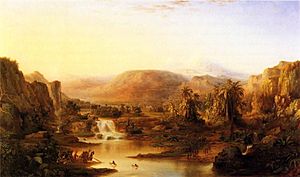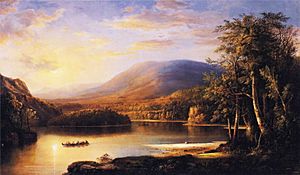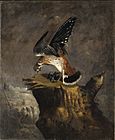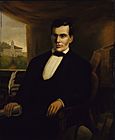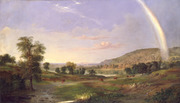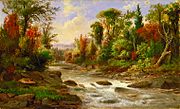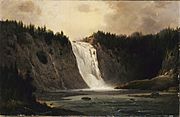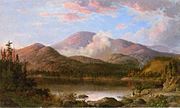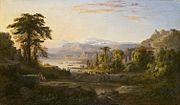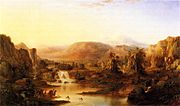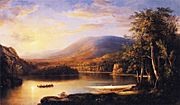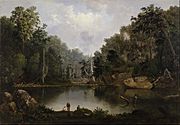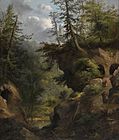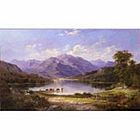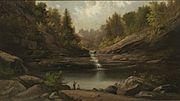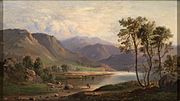Robert S. Duncanson facts for kids
Quick facts for kids
Robert Seldon Duncanson
|
|
|---|---|
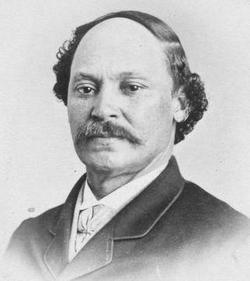
Robert S. Duncanson
|
|
| Born | 1821 Fayette, New York, U.S.
|
| Died | December 21, 1872 Detroit, Michigan, U.S.
|
| Education | Self taught |
| Known for | Landscape painting |
| Movement | The Hudson River School, The Ohio River Valley style |
Robert Seldon Duncanson (1821 – December 21, 1872) was a famous American landscape painter from the 1800s. He had both European and African roots. Duncanson was inspired by well-known artists like Thomas Cole. He created many beautiful landscape paintings. He is seen as a second-generation artist of the Hudson River School, a group of painters known for their nature scenes.
Duncanson spent most of his career in Cincinnati, Ohio. He helped create a special style of landscape painting for the Ohio River Valley area. As a free Black man in America before the Civil War, Duncanson worked with people who wanted to end slavery, both in America and England. They helped support and promote his art. Duncanson is thought to be the first African-American artist to become famous around the world. He was active in art communities in Cincinnati, Detroit, Montreal, and London.
Today, art experts often discuss if Duncanson's paintings secretly talked about racial issues of his time. Some experts, like Joseph D. Ketner, think he used hidden messages about race in his art. Others, like Margaret Rose Vendryes, believe we should not look at his art only through the lens of race.
Contents
Robert Duncanson's Early Life
Robert Seldon Duncanson was born in Fayette, New York, in 1821. He was one of five sons born to John Dean Duncanson and Lucy Nickles. His father was a free Black tradesman, meaning he worked in skilled jobs like carpentry. Robert's family had ancestors who were once enslaved in Virginia but later became free.
In 1828, Robert's family moved to Monroe, Michigan. His father did well there as a house painter and carpenter. This success allowed him to support his family and educate his children. Robert and his brothers learned these family trades. Robert was the most talented among his siblings. In 1838, he started his own painting business. However, in 1839, he decided to focus on becoming a portrait painter instead.
In 1840, when he was 19, Duncanson moved to Mount Pleasant, Ohio, near Cincinnati. He wanted to start his career in fine arts. Cincinnati was a fast-growing city and a popular place for free Black people. It had one of the largest African-American communities in the U.S.
Cincinnati was also known as "the Athens of the West" because of its strong art scene. Many landscape artists became famous there, including William Louis Sonntag Sr., Godfrey Frankenstein, and Worthington Whittredge. Duncanson was drawn to this lively art community.
Robert Duncanson's Art Career
Traveling Portrait Painter
Robert Seldon Duncanson did not go to art school. He taught himself by copying other artists' works, sketching nature, and painting portraits. In the 1840s, he worked as a traveling portrait painter. He moved between Cincinnati, Detroit, and Monroe, Michigan, painting people's pictures.
His first known painting is The Portrait of a Mother and Daughter from 1841. In 1842, three of his portraits were shown at an exhibition in Cincinnati. This was his first public art show, and his work was well-received. However, because of his race, Duncanson likely could not take art classes at the Academy. His family was also not allowed to attend the show.
In 1844, Duncanson worked with a photographer named Coates. They created "Chemical Paintings" that looked like early photographs. Duncanson helped design the pictures, and Coates handled the technical parts. Even though Duncanson was doing well, he didn't get enough commissions. So, in 1845, he went back to being a traveling portrait painter, mostly in Detroit.
While in Detroit, local newspapers praised Duncanson's skills. He got many portrait jobs, including a big one from the important Berthelet family. But Duncanson became more interested in painting scenes from everyday life, called genre painting. He returned to Cincinnati in 1846 to try new kinds of art.
Becoming a Landscape Painter
Landscape painting was very popular from the 1830s to the 1900s. Artists like Thomas Cole and others from the Hudson River School used nature to show ideas about America. Duncanson was very interested in this style. He began to study travel books with pictures of exotic places.
In 1848, he received a job from Charles Avery, a minister who wanted to end slavery. Duncanson painted Cliff Mine, Lake Superior for Avery. This painting helped his career as a landscape painter. It also connected him with a group of people who supported ending slavery and who would help him throughout his career.
After this, Duncanson focused on landscape painting. He and two other Cincinnati artists, Worthington Whittredge and William Louis Sonntag Sr., were inspired by the Hudson River School. They traveled around the country to sketch nature scenes. Duncanson then focused on the Ohio River Valley in the early 1850s. He wanted to make his landscape paintings more romantic and artistic, like those of Thomas Cole.
Around 1850, Duncanson got his biggest job ever from Nicholas Longworth, a very rich man in Cincinnati. Longworth asked him to paint eight large landscape panels for his home, Belmont. These paintings are considered some of the best house murals from before the Civil War. In 1851, Duncanson also painted Blue Hole, Flood Waters, Miami River.
In 1853, Duncanson took a "grand tour" of Europe, like many artists did. This trip showed him famous artworks and inspired many of his future landscape paintings. In 1859, he finished Landscape with Rainbow. This painting was called "one of the most beautiful pictures." It was even shown during Joe Biden's inauguration in 2021.
In 1861, Duncanson created what many call his "greatest work": Land of the Lotus Eaters. He planned for this painting to be shown on a tour in Europe.
European Travels and Art Inspired by Books
Many of Duncanson's paintings, like Land of the Lotus Eaters, were influenced by British poets. They included mythical themes in his art. He developed this interest during his many trips to Europe over 20 years. These trips were paid for by people in Cincinnati who wanted to end slavery. These trips allowed Duncanson to study old master paintings and explore Europe's historic landscapes. Two paintings from his European trips are Italian Landscape and Italian Landscape with Ruins.
Support from People Against Slavery
Duncanson's success was partly due to the many people who supported him because they wanted to end slavery. These supporters gave him many jobs, bought his paintings, paid for his travels, and introduced him to other important people in the art world. They supported artists like Duncanson to show that African Americans could contribute to mainstream culture.
Sometimes, these supporters would ask for paintings that clearly showed themes about race and slavery. Duncanson may have received more support because he had a lighter skin tone due to his mixed heritage. This sometimes gave artists with lighter skin more opportunities than African Americans with darker skin.
While Duncanson never directly painted about race issues, some historians debate if he hinted at them. For example, Joseph Ketner II thinks that in Duncanson's Garden of Eden (1852), the "paradise with its palm trees might also be the promised land of slave songs."
Uncle Tom and Little Eva, 1853
Robert Duncanson’s Uncle Tom and Little Eva, painted in 1853, is at the Detroit Institute of Arts. This painting shows how much Duncanson grew as a landscape painter. It shows a scene from Harriet Beecher Stowe's famous anti-slavery book, Uncle Tom's Cabin.
The book has many violent scenes about slavery, but Duncanson chose a peaceful one. He painted two characters, a slave named Tom and a young girl named Eva, in a beautiful landscape. Tom and Eva are looking up at the sky, towards heaven, by Lake Pontchartrain in Louisiana. This scene is important in the book because it talks about finding freedom from slavery through spiritual love.
Reverend James Francis Conover, a strong supporter of ending slavery, asked Duncanson to paint this work. While some art historians believe Duncanson's paintings had hidden meanings about race, Uncle Tom and Little Eva is his only painting that directly shows an anti-slavery story.
As a free Black artist before the Civil War, Duncanson could have made strong statements about race. But he usually did not. He once wrote to his son, "I have no color on the brain; all I have on the brain is paint." Some art historians think Duncanson wanted to criticize slavery with this painting. Others believe he painted it mainly to please his supporters who wanted to end slavery.
Nicholas Longworth's Belmont Mansion
Duncanson's success in Cincinnati led to important jobs, like the one for Nicholas Longworth, one of the city's richest people. In 1851, Longworth asked Duncanson to paint murals on the walls of his home, the Belmont Mansion.
Duncanson created eight large murals for the entrance, each nine feet high. They showed landscapes of the American West. Longworth chose Duncanson because he thought he was "one of our most promising painters." Duncanson's earlier training as a house painter helped him with this big job.
His work on the Belmont Mansion murals made him much more popular in Cincinnati, especially among white people who wanted to end slavery. The murals were later covered by wallpaper but were found again in 1933. They are now displayed at the Taft Museum of Art in Cincinnati.
Working with Photographer James Presley Ball
Starting in 1854, Duncanson worked in the photography studio of James Presley Ball, a well-known African-American photographer. Duncanson helped by touching up portraits and adding color to photographs.
In 1855, Duncanson and Presley Ball created a huge anti-slavery panoramic painting. It was called Mammoth Pictorial Tour of the United States Comprising Views of the African Slave Trade. This large artwork toured across the country. It showed scenes of the African slave trade, sugar and cotton plantations, and American landscapes.
Time Away and International Fame
When the Civil War began, Duncanson left the U.S. and went to Canada and the United Kingdom. In 1863, he settled in Montreal, Canada, for two years. The Canadian landscape inspired him, and this can be seen in his paintings from that time. He became well-known in the Canadian art scene and inspired Canadian painters. People in Canada saw him as one of their first professional artists. Duncanson had a big impact on 19th-century Canadian art. He even helped start the first Canadian school of landscape painting.
In 1865, he left Canada for the United Kingdom, visiting England and Scotland. He toured with one of his most famous works, The Land of the Lotus Eaters (1861). In Europe, his art was very popular. The important London Art Journal called him a master of landscape painting.
In the winter of 1866–1867, Duncanson returned to Cincinnati. His European travels inspired him to paint many scenes of the Scottish landscape. His time in Canada and the United Kingdom helped him become even more famous around the world.
Ellen's Isle, Loch Katrine, 1871
This painting was inspired by a poem from 1810 by Scottish writer Sir Walter Scott, called The Lady of the Lake. This poem was important to several African American leaders, like W. E. B. Du Bois and Frederick Douglass.
Art historian Joseph D. Ketner believes Ellen's Isle, Loch Katrine is the best example of Duncanson's artistic skill. The painting shows how Duncanson used the style of the Hudson River School artists. It also shows his own romantic way of seeing landscapes.
Final Years
Throughout his career, Duncanson's paintings often showed calm and peaceful nature scenes. His later works continued to show his love for landscape painting. In his final years, Duncanson developed a serious illness that affected his mind, possibly from lead poisoning. This illness caused him to act strangely. He started to believe he was possessed by a master painter.
Even though he kept painting, his health and behavior worried his supporters. In 1872, Duncanson had a seizure while setting up an exhibition in Detroit. He died on December 21, 1872, at 51 years old. He was buried in the Woodland Cemetery in Monroe, Michigan.
Robert Duncanson's Legacy
Robert Seldon Duncanson was one of the few African American landscape painters in the 1800s. He became more successful than other artists of his time. By the 1860s, American newspapers called him the "greatest landscape painter in the West." London newspapers also praised him as highly as British artists.
Richard Powell of American Visions says Duncanson’s success was a "victory over society’s presumptions of what African-American artist should create." Duncanson became famous for his landscape paintings, which were inspired by the Hudson River School. He is also known for helping to develop the art style of the Ohio River Valley. Art historian Joseph D. Ketner says Duncanson's biggest contribution was his "distinctive vision of landscape painting with allusions to popular romantic literature."
Duncanson was largely forgotten in American art history until his work was rediscovered in the 1950s and 1960s. For many years, art historians told a false story about him. But starting in the 1990s, experts like Ketner researched Duncanson's life and work to create a true picture of the artist.
The main debate about Duncanson is whether his art showed racial issues. Some art historians, like Ketner, think his paintings had hidden racial meanings. Others, like Vendryes, believe his landscapes were "race-free." Ketner argues that Duncanson's art showed his cultural and racial identity. Vendryes warns against looking at Duncanson and his art only through his race, as it might limit understanding his work.
Since 1986, the Taft Museum of Art in Cincinnati, Ohio, has had a special program for modern African-American artists. This program honors Duncanson.
List of Robert Duncanson's Artworks
- Portrait of a Mother and Daughter, 1841 (Fulton County Arts Council, Hammonds House, Atlanta, Georgia)
- Trial of Shakespeare, 1843 (Douglass Settlement House, Toledo, Ohio)
- Roses Fancy Still Life, 1843 (National Museum of American Art, Smithsonian Institution, Washington, D.C.)
- Mt. Healthy, Ohio, 1844 (National Museum of American Art, Smithsonian Institution, Washington, D.C.)
- Drunkard's Plight, 1845 (Detroit Institute of Arts, Detroit, Michigan)
- At the Foot of the Cross, 1846 (Detroit Institute of Arts, Detroit, Michigan)
- Cliff Mine, Lake Superior, 1848 (F. Ward Paine, Jr., Portola Valley, California)
- Mayan Ruins, Yucatan, 1848 (Dayton Art Institute, Dayton, Ohio)
- The Belmont Murals, c. 1850–1852 (Taft Museum, Cincinnati, Ohio)
- Blue Hole, Flood Waters, Little Miami River, 1851 (Cincinnati Art Museum, Cincinnati, Ohio)
- View of Cincinnati, Ohio From Covington, Kentucky, 1851 (Cincinnati Historical Society)
- The Garden of Eden (after Cole), 1852 (High Museum of Art, Atlanta, Georgia)
- Dream of Arcadia (after Cole), 1852 (Private Collection, New York City)
- Uncle Tom and Little Eva, 1853 (Detroit Institute of Arts, Detroit, Michigan)
- Italianate Landscape, 1855 (California African American Museum, Los Angeles, California)
- Robbing the Eagle's Nest, 1856 (National Museum of African American History and Culture)
- Untitled (Landscape), late 1850s (Princeton University Art Museum)
- Landscape with Rainbow, 1859 (National Museum of American Art, Smithsonian Institution, Washington, D.C.)
- Land of Lotus Eaters, 1861 (Collection of His Royal Majesty, the King of Sweden)
- Faith, 1862 (National Afro-American Museum and Cultural Center, Wilberforce, Ohio)
- Vale of Kashmir, 1863 (Cleveland Museum of Art, Cleveland, Ohio)
- Silver River, North Carolina, 1863 (The Columbia Museum of Art, Columbia, South Carolina)
- Lake Beauport, 1864 (Musée national des beaux-arts du Québec, Québec, Canada)
- Lake Saint-Charles, 1864 (Musée national des beaux-arts du Québec, Québec, Canada)
- A Dream of Italy, 1865 (Birmingham Museum of Art, Birmingham, Alabama)
- Cottate Opposite Pass at Ben Lomond, 1866 (Museum of Art, North Carolina Central University, Durham, North Carolina, purchase)
- Mountain Landscape with Cows and Sheep, 1866 (Newark Museum, Newark, New Jersey, purchase)
- Loch Long, Scotland, 1867 (National Museum of American Art, Smithsonian Institution, Washington, D.C.)
- The Caves, 1869 (Amon Carter Museum of American Art)
- Dog's Head Scotland, 1870 (Museum of Fine Arts, Boston, Boston, Massachusetts)
Gallery
-
The Caves (1869), Amon Carter Museum of American Art
-
Mountain Landscape with Cows and Sheep, (1866), Newark Museum
Exhibitions
- 1842: Annual Exhibition of Paintings and Statuary, Western Art Union, Cincinnati, Ohio
- 1843: Annual Exhibition of Paintings and Statuary, Western Art Union, Cincinnati, Ohio
- 1864: Art Association of Montreal, Montreal, Canada
- 1865: Dublin Exhibition, Art Association of Montreal, Ireland
- 1871: Western Art Gallery, Detroit, Michigan
- 1943: Balmoral Castle, Scotland, Museum of Modern Art, New York City
- 1953: Denver Art Museum, Denver, Colorado
- 1955: Cincinnati Art Museum, Cincinnati, Ohio
- 1961: Indianapolis Museum of Art Indianapolis, Indiana
- 1967: Howard University Gallery of Art, Washington, D.C.
- 1970: La Jolla Museum of Contemporary Art, La Jolla, California
- 1971: Bowdoin College, Museum of Contemporary Art, Brunswick, Maine
- 1972: Cincinnati Art Museum, Cincinnati, Ohio
- 1972: Museum of Fine Arts, Boston, Boston, Massachusetts
- 1976: Los Angeles County Museum of Art, Los Angeles
- 1979: Detroit Institute of Arts, Detroit, Michigan
- 1983: National Museum of American Art, Washington, D.C.
- 1992: National Museum of American Art, Washington, D.C.
- 1996: Mildred Lane Kemper Art Museum, Washington University in St. Louis, Missouri
- 1999: To Conserve a Legacy - American Art from History, Black Colleges and Universities, Studio Museum in Harlem, New York City
- 2003: Then and Now: Selection of 19-20th Century Art by African American Artists, Detroit Institute of Arts, Detroit, Michigan
- 2009: Cincinnati Art Museum, Cincinnati, Ohio
See also
 In Spanish: Robert S. Duncanson para niños
In Spanish: Robert S. Duncanson para niños


